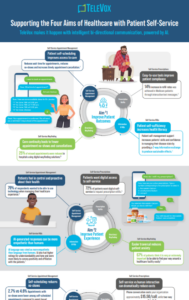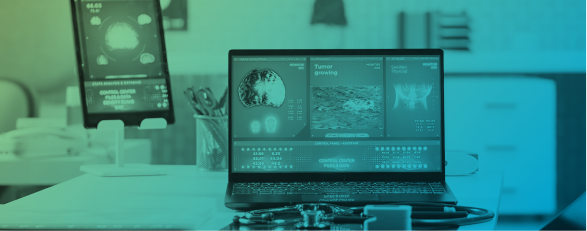AI and its related tech have changed the way healthcare works across all departments and…

Empowering Patients and Providers: Advancing Healthcare’s Four Aims Through Patient Self-Service
Patient self-service refers to digital tools that allow individuals to independently manage aspects of their healthcare experience—such as scheduling appointments, checking in, paying bills, accessing medical records, and communicating with providers. These solutions put patients in control, offering convenience and transparency without requiring direct staff involvement.
In today’s digital-first world, patients expect healthcare to be as accessible and intuitive as the services they use every day. Yet healthcare organizations are under growing pressure to improve outcomes, elevate patient experiences, reduce operational costs, and ease provider burnout—all at once. The solution? Leveraging patient self-service tools as a key enabler of more efficient, patient-centered care. By shifting routine interactions to digital channels, organizations can better support the Four Aims of Healthcare: improving outcomes, enhancing the patient experience, lowering costs, and boosting provider satisfaction.
1. Improving Patient Outcomes
Improving health outcomes begins with increasing access to care. Self-scheduling tools are one of the most effective ways to accomplish this, as they enable patients to easily book, cancel, or reschedule appointments. Patients who self-schedule are less likely to miss appointments—translating to an estimated $150 million in annual cost avoidance for healthcare systems. Beyond improving access, self-scheduling tools also enhance continuity of care by minimizing wait times, no-shows, and cancellations through automated reminders and streamlined digital workflows1.
Medication adherence, a key factor in improving health outcomes, is also positively impacted by self-service tools. Prescription refill features, along with automated reminders, have been shown to increase patient compliance by 14%2. By empowering patients to manage their refills independently, these solutions reduce the need for phone calls and waiting on hold, ultimately supporting better treatment adherence. By offering clear, timely communications, these tools help improve patient engagement and health literacy, leading to more informed and proactive individuals.
2. Enhancing the Patient Experience
Today’s healthcare consumers demand convenience and control. In fact, when given the tools to manage their healthcare, 79% of patients want to be able to use technology when managing their health,(5) – which makes them feel more in control of their health. By providing self-service options that are available 24/7, healthcare providers can meet these expectations, reducing friction in the patient experience and fostering a greater sense of autonomy.
Moreover, AI-powered digital assistants can answer common patient inquiries quickly and accurately, eliminating the need for direct interaction with staff. From medication instructions to clinic hours, patients receive immediate, reliable responses that enhance satisfaction and trust. Navigating healthcare facilities can also be a source of stress for patients, but interactive maps and directions simplify this process, helping patients easily find their way around and reducing anxiety, especially in large hospital settings.
3. Reducing Costs Across the System
Healthcare organizations are under increasing financial strain, and self-service solutions are playing a crucial role in reducing costs. Patient self-scheduling not only reduces the administrative burden on staff but also helps prevent lost revenue from missed appointments. Automated text messaging, which replaces traditional outbound calls, is another cost-effective solution. With messaging costs ranging from $1-5 via texting compared to approximately $15.50 per call, healthcare systems can significantly reduce communication costs(10).
In addition to lowering direct costs, self-service tools also help reduce staff workload. By enabling patients to access their lab results, request prescription refills, and navigate their healthcare journey independently, healthcare workers can focus on more complex tasks that require human expertise. This streamlined approach helps reduce costly inefficiencies, such as staff downtime—currently, 40% of staff time is spent waiting for patients3. Digital workflows help close this gap, ensuring that schedules remain on track and reducing idle time.
4. Improving Provider Satisfaction
Healthcare providers are facing unprecedented levels of burnout, with repetitive administrative tasks contributing significantly to stress. Automation of routine tasks such as appointment reminders and follow-ups can reduce this burden, allowing providers to focus on the higher-value aspects of patient care. In fact, 47% of non-clinical staff report burnout due to repetitive tasks12, and by automating these processes, healthcare systems can alleviate this strain.
Additionally, prescription refill requests make up a large portion of the provider’s inbox volume. One facility reported that, on average, prescription refill messages took up 16% of the total message volume(13), contributing to digital overload. By enabling patients to manage their own refills, providers can significantly reduce this volume, lightening their digital workload and allowing them to dedicate more time to direct patient care.
Finally, with healthcare providers often citing patient preparation as a key challenge, physicians spend 50% of their time educating patients. Patients frequently come in unprepared or unsure about their care plans—access to pre-visit instructions can mitigate the work that falls on the physician. By providing clear guidelines ahead of appointments, patients arrive more informed and ready for meaningful interactions, leading to better care outcomes and a reduction in provider frustration.
The Future of Healthcare is Patient Self-Service Tools
The healthcare industry is facing tough challenges, but integrating patient self-service tools can go a long way in solving many of them. By focusing on the Four Aims of Healthcare—improving outcomes, enhancing patient experiences, reducing costs, and easing provider burnout—these tools don’t just make operations smoother; they help create a more patient-focused, efficient, and sustainable healthcare system. As the healthcare landscape continues to change, these innovations will play a crucial role in delivering smarter, more connected care that benefits both patients and providers.
Download the Full White Paper
 Read the full infographic here: Supporting the Four Aims of Healthcare with Patient Self-Service. Take the next step in enhancing your healthcare delivery with patient self-service solutions. Visit TeleVox to learn more about how we can help you empower both patients and providers.
Read the full infographic here: Supporting the Four Aims of Healthcare with Patient Self-Service. Take the next step in enhancing your healthcare delivery with patient self-service solutions. Visit TeleVox to learn more about how we can help you empower both patients and providers.
Sources:
1. Chung S, Martinez MC, Frosch DL, Jones VG, Chan AS. Patient-Centric Scheduling with the Implementation of Health Information Technology to Improve the Patient Experience and Access to Care: Retrospective Case-Control Analysis. J Med Internet Res. 2020 Jun 10;22(6):e16451. doi: 10.2196/16451. PMID: 32519970; PMCID: PMC7315363.
2. Brar Prayaga R, Jeong EW, Feger E, Noble HK, Kmiec M, Prayaga RS. Improving Refill Adherence in Medicare Patients With Tailored and Interactive Mobile Text Messaging: Pilot Study. JMIR Mhealth Uhealth. 2018 Jan 30;6(1):e30. doi: 10.2196/mhealth.8930. PMID: 29382623; PMCID: PMC5811648.
3. https://www.goziohealth.com/blog/patients-are-getting-lost-in-hospitals-12-stats-show-what-that-costs
4. Dineen-Griffin S, Garcia-Cardenas V, Williams K, Benrimoj SI (2019) Helping patients help themselves: A systematic review of self-management support strategies in primary health care practice. PLoS ONE 14(8): e0220116. https://doi.org/10.1371/journal.pone.0220116
5. https://www.mgma.com/mgma-stats/digital-check-in-can-boost-patient-satisfaction-and-practice-efficiency-amid-staffing-shortages
6. https://www.hhmglobal.com/knowledge-bank/articles/is-ehealth-enough-to-satisfy-patients-desire-for-self-service
7. https://www.fiercehealthcare.com/ai-and-machine-learning/gen-ai-human-drafted-patient-messages-similar-quality-though-tech-more
8. Woodcock E, Sen A, Weiner J. Automated patient self-scheduling: case study. J Am Med Inform Assoc. 2022 Aug 16;29(9):1637-1641. doi: 10.1093/jamia/ocac087. PMID: 35652165; PMCID: PMC9382371.
9. https://www.mgma.com/articles/better-patient-communication-to-deter-no-show-appointments
10. https://www.demandhub.co/articles/text-messaging-in-healthcare/
11. Babel A, Taneja R, Mondello Malvestiti F, Monaco A, Donde S. Artificial Intelligence Solutions to Increase Medication Adherence in Patients With Non-communicable Diseases. Front Digit Health. 2021 Jun 29;3:669869. doi: 10.3389/fdgth.2021.669869. PMID: 34713142; PMCID: PMC8521858.
12. Rotenstein, L.S., Brown, R., Sinsky, C. et al. The Association of Work Overload with Burnout and Intent to Leave the Job Across the Healthcare Workforce During COVID-19. J GEN INTERN MED 38, 1920–1927 (2023). https://doi.org/10.1007/s11606-023-08153-z
13. https://www.ama-assn.org/practice-management/digital/9-steps-reduce-ehr-inbox-and-stress-system-level
14. Miller, Robert H., et al. “Automated Pre- and Post-Surgery Program Saves Physicians Time on Educating and Instructing Surgical Patients.” Journal of the American Medical Association 284.19 (2000): 2472-2476.



